Grand Warszawski/iStock via Getty Images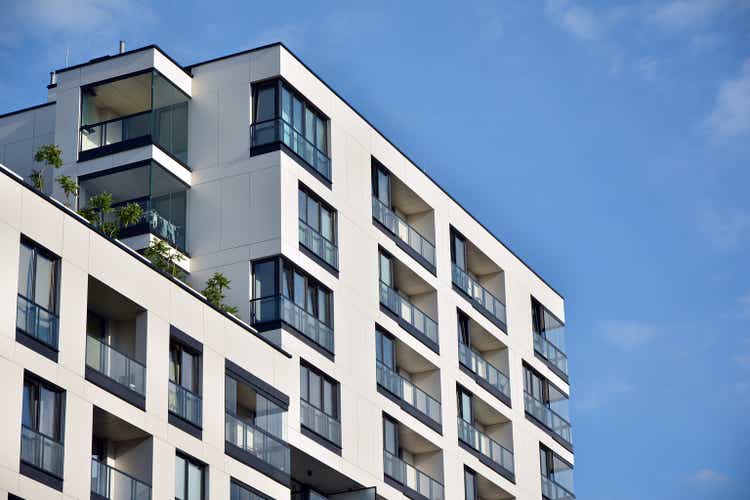
REIT Rankings: Apartments
This is an abridged version of the full report published on Hoya Capital Income Builder Marketplace on August 2nd.
Renting or owning – housing has become significantly more expensive over the past three years as pre-existing secular tailwinds were given an added pandemic-related accelerant. While the era of 15-20% increases in home prices and rents may be coming to an end, renters shouldn’t expect significant relief anytime soon – and the inflationary effects will be felt for years to come. Apartment REITs continue to report stellar earnings results with record-setting rent growth while simultaneously managing to increase occupancy rates to record-highs and reduce turnover rates to record-lows. Within the Hoya Capital Apartment REIT Index, we track the fifteen largest apartment REITs which collectively account for roughly $150B in market value, $300B in total asset value, and own over a million rental units across the United States.
Renters across the nation have been receiving an unwelcome surprise at end of their lease term in recent quarters, most of which have seen – or will soon see – a double-digit percentage increase on their renewal offer. After shopping the market, many renters soon realize they may be sitting on the best deal available, underscored by another quarter of historically high occupancy rates and record-low turnover rates reported by apartment REITs with broad-based strength seen across both Sunbelt and Coastal-focused markets. As discussed in our REIT Earnings Halftime Report, apartment REIT earnings results were impressive across the board in the second quarter with all ten major apartment REITs raising their full-year property-level guidance, indicating that higher mortgage rates have simply shifted the robust housing demand from the ownership market back towards the rental markets while supply growth has been insufficient to meet the robust demand.
Despite a stellar slate of earnings results from the apartment sector in which all ten REITs raised their full-year guidance, the sector continues to trade near its cheapest valuations in a decade amid concern that the rate-driven slowdown in the homeownership markets and the broader economic slowdown will bleed into the rental markets – concerns that we believe are premature given the relatively countercyclical nature of apartment demand. In its most recent rent report, Zumper reported that rent growth reaccelerated in July to an 11.3% year-over-year rate after showing some signs of moderation in the prior two months. Data from Zillow (Z) shows that annual rent growth has remained around 15% throughout 2022 with 50 of the top 60 markets seeing rent growth in excess of 10% in its most recent June report.
Naturally, the historic pace of rent growth has normalized a bit over the past two quarters – particularly in many of the resurgent Sunbelt and Mountain West markets that were posting rent growth above 25% earlier this year – but renters holding out hope for some “free rent” or other concessions will likely be disappointed. Consistent with recent data from Yardi Matrix, Apartment List reported last week that while rents are rising more slowly than they did in 2021, the pace is still double that of pre-pandemic years. Over the first seven months of 2022, rents have increased by a total of 6.7%, shy of the 12.0% over the same months of 2021 but well ahead of the 4.0% rate in 2017, 4.5% in 2018, 4.1% in 2019, and -0.4% in 2020. Data from Yardi shows similar themes with its survey noting that national rents have increased by $73 since the start of 2022 through the end of June to an average of $1,706. The rise represents a 13.7% percent year-over-year increase, 50 basis points lower than it was in May and 130 basis points off the February peak.
Measures of market rents likely understate the “embedded” growth resulting from the historically wide spread between new lease rates and in-place rents as apartment owners have had to limit renewal increases in many states and cities due to regulatory limits. Apartment REITs reported new lease rate growth of 17.5% in Q2 while renewal rent growth averaged 12.4% – a differential that has persisted since late 2021. This spread has been especially wide in the Coastal markets, which are now accelerating at a slightly faster pace than the Sunbelt as these markets “catch up” with the incredible double-digit growth seen in the Sunbelt throughout the pandemic. Apartment Income (AIRC), for example, estimated that its “loss to lease” – the spread between in-place rents and market rents – was above 10% in the second quarter while Essex (ESS) noted that its loss to lease was “one of the strongest loss to lease in the Company’s history at 10.3%”, indicating that transacted rates will remain strong for the balance of 2022 and into next year.
As noted above, fueled by these double-digit rent increases, each of the ten major apartments raised their full-year same-store NOI growth target – which is now expected to average more than 13% this year – while eight of the ten boosted their full-year Funds From Operations (“FFO”) target – which is now expected to average 19.0% this year. Led on the upside by Essex, AvalonBay (AVB), and Equity Residential (EQR), the upside revisions were more substantial across the Coastal-focused REITs with an average increase to FFO guidance of 310 basis points compared to their Sunbelt peers which raised their FFO growth targets by an average of 150 basis points. Occupancy rates increased to 96.6% for the Coastal REITs – an increase of 30 basis points from last year – while Sunbelt REITs reported average occupancy of 95.5% – lower by 25 basis points from their record-high rates last year.
Also of note, Coastal REITs expect more modest expense growth this year of just 3.6% – far below the broader inflation rate and the 6.2% average increases expected by Sunbelt REITs – driven by a significant decline in turnover rates compared to 2021, which is again consistent with these broader “catch-up” effects. If these FFO targets are met, apartment REITs will have delivered average cumulative FFO growth of 22.8% since the start of the pandemic – a quite impressive feat considering the distress reported by Coastal-focused REITs early in the pandemic. Sunbelt REITs never skipped a beat during the pandemic and now expect 2022 FFO levels to be 36.3% above their pre-pandemic rate from 2019 while Coastal REITs now expect 2022 FFO levels to be 9.3% above 2019-levels.
Deeper Dive: Macro Fundamentals
Taking a step back to a more macro-level, while goods shortages and the resulting inflation should gradually ease over the next year as economic growth cools and as supply chain headwinds finally ease, elevated levels of housing inflation will likely persist into the back half of the decade, and we expect that the Shelter component of CPI will resume its role as the primary driver of inflation. We’ve discussed for many months how the historic surge in rents has not yet been captured by the BLS inflation metrics which showed cumulative rent inflation of just 7.7% since the end of 2019 – substantially below the 24.1% cumulative rent growth reported in Zillow data. The delayed recognition of shelter inflation alone will add an estimated 0.6-1.2% to the Core CPI index in 2022 and 2023.
While the near- and medium-term outlook remains very compelling, supply growth is a potential looming longer-term headwind as soaring rent growth has sparked a new wave of development. After several years of muted supply growth, multifamily starts and units-under-construction have climbed to multi-decade highs, but elongated construction timelines and lingering supply chain issues continue to limit completions. Given the hearty fundamentals of near-record-high occupancy rates and record-low turnover rates – combined with the discounted valuations – apartment REITs appear well-equipped to outperform through the inevitable normalization.
Taking a step back, from an investment perspective, apartment demand is driven primarily by demographics, employment growth, and wage growth. Apartment REITs have benefited from extremely favorable millennial-led demographic trends over the last decade, a trend that still has a few more years left to run, particularly in sunbelt cities that are attracting an increasingly larger share of 25-35-year-old “prime-age” renters. Apartment REITs are also among the more operationally “efficient” real estate sectors, commanding a relatively low operating and overhead expense profile and requiring fairly modest ongoing capital expenditures compared to other sectors like retail, hotel, and office. Importantly, residential real estate has also proven to be one of the best inflation hedging assets over the last century not only in the U.S. but also across different regions.
For the undersupplied housing industry, we expect the favorable supply/demand imbalance to persist for the foreseeable future amid ongoing constraints on new home construction while demographic-driven and WFH-driven demand remain resilient. Freddie Mac estimates that the U.S. housing market is 3.8 million homes short of what’s needed to meet the country’s demand, representing a 52% rise in the nation’s housing shortage compared with 2018. These record-low inventory levels of homes have resulted in rent growth and home price appreciation persistently above the rate of inflation throughout the past decade – a very positive long-term fundamental backdrop not only for apartment REITs, but across the broader U.S. housing industry.
Apartment REIT Stock Performance
Despite a stellar slate of earnings results from the apartment sector in which all ten REITs raised their full-year guidance, apartment REITs have lagged the broader REIT Index this year amid concern that the rate-driven slowdown in the homeownership markets and the broader economic slowdown will bleed into the rental markets – concerns that we believe are premature. The Hoya Capital Apartment REIT Index is lower by 20.0% this year, lagging the 16.5% decline from the broad-based Vanguard Real Estate ETF (VNQ) and the 14.1% decline from the S&P 500 ETF (SPY). The underperformance this year follows the best year on record for apartment REITs with total returns of 58%
Apartment REITs have been some of the strongest-performing REITs over most long-term measurement periods. From 2010 through 2021, Apartment REITs delivered average annual returns of 16.4%, outpacing the 14.4% annual total returns from the broad-based REIT average during that time. Among the eight major apartment REITs, Mid-America (MAA) and Camden Property (CPT) have delivered the strongest 5-year total returns, but these Sunbelt-focused REITs have lagged their Coastal peers this year. Interestingly, three small-cap REITs have been the strongest performers this year led by Aimco (AIV), BRT Apartments (BRT) and Clipper Realty (CLPR) while Veris Residential (VRE) has continued to underperform since its rebranding and strategy shift from an office REIT into an apartment REIT 2021.
While we gained a pair of new apartment REITs through strategy-shifts, Blackstone (BX) picked off a trio of multifamily REITs over the past year for its nontraded REIT, Blackstone Real Estate Income Trust (“BREIT”). Last December, Blackstone agreed to acquire Bluerock Residential Growth REIT (BRG) in an all-cash transaction valuing the REIT at $3.6 billion at $24.25/share – a roughly 80% premium from its pre-announcement share price. Two months later, Blackstone agreed to acquire Preferred Apartment (APTS) in a $5.8B deal at $25 /share – a 40% premium from its pre-announcement price and then in April, Blackstone acquired student housing REIT American Campus (ACC) in a $12.8 billion takeout at $65.47/share bid – a 14% premium to ACC’s prior close. The acquisitions of BRG and APTS closed in June while the ACC acquisition is expected to close this quarter.
Deeper Dive: Apartment REIT Portfolios
As goes the U.S. housing industry, so goes the U.S. economy. The $4-5 trillion U.S. multifamily apartment market is highly fragmented, with these sixteen REITs owning roughly 1,000,000 of the estimated 25 million multifamily rental units across the US, which is only about 2-4% of the total rental apartment stock. Multifamily rental units comprise roughly 15% of all housing units in the United States, and these apartment REITs comprise roughly 15% of the Hoya Capital Housing Index, the housing industry benchmark that tracks the performance of the U.S. housing sector.
As a sector, apartment REITs collectively have fairly balanced geographical exposure across most of the major U.S. markets. Individual apartment REITs tend to focus on either coastal markets or sunbelt and secondary markets and own portfolios that typically include a blend of luxury high-rise, mid-rise, and garden-style apartment communities. Coastal apartment REITs include Equity Residential, AvalonBay, Essex, Apartment Income, UDR (UDR), and AIMCO, while sunbelt-focused apartment REITs include Camden, Mid-America, Independence (IRT), and NexPoint Residential (NXRT). In a category of its own, Centerspace (CSR) focuses primarily on Midwest and Mountain West markets with its major markets being Minneapolis, Omaha, and Denver.
We’ve also seen a pair of office REITs shift their focus to become pure-play multifamily REITs over the last year: Washington REIT (WRE), and Veris Residential – formerly Mack-Cali. Perhaps even more important than their geographical distribution, the distribution of portfolios towards either urban or suburban has taken on added significance throughout the pandemic as suburban properties surrounding the hardest-hit “shutdown cities” have seen some of the strongest rates of rent growth both in the multifamily and single-family rental categories. For example, NYC suburbs Stamford and New Haven, Connecticut saw some of the strongest rates of rent growth since at least 2015 as flexible remote work options have lessened the burden of the longer suburban commutes. We’ve seen some modest reversals in these trends in 2022, however, as the post-pandemic reopenings have led to particularly strong rent growth in New York City.
The larger apartment REITs are generally some of the most well-capitalized companies across the REIT sector – a critical attribute during the pandemic-related turbulence – but several of the small-cap apartment REITs do operate with elevated debt levels. The seven largest apartment REITs command investment-grade credit ratings from Standard & Poor’s, led by A- ratings by AvalonBay, Equity Residential, and Camden. The larger REITs in the sector also tend to rank high on the corporate governance scale with shareholder-friendly governance structures. NexPoint Residential is the lone externally-managed REIT in the sector but has nevertheless delivered sector-leading performance.
Apartment REIT Dividend Yields
Apartment REITs pay an average dividend yield of 3.1%, which is slightly below the REIT market-cap-weighted sector average of 3.2%. Since the start of 2015, apartment REITs have delivered average annual dividend growth of roughly 2.8%, but pay out only around 65% of their available cash flow, giving these companies the flexibility to take advantage of external growth opportunities or to increase distributions. Nine apartment REITs raised their dividend last year while another nine have raised their payouts this year as well with Mid-America and NexPoint delivering the strongest rate of increase. The ten mid- and large-cap apartment REITs pay dividend yields ranging from 2.25% to 4.12% while small-cap BRT Apartments and Clipper pay dividend yields of 4.5% and 4.2%, respectively.
Takeaway: Plenty of ‘Embedded’ Growth Left
Despite a stellar slate of earnings results from the apartment sector in which all ten REITs raised their full-year guidance apartment REITs have lagged this year and the sector now trades at historically cheap valuations. We see plenty of “embedded” growth remaining given the historically wide spread between new lease rates and in-place rents, particularly in coastal markets which are now accelerating at a slightly faster pace than the Sunbelt as these markets “catch up” with the incredible double-digit growth seen in the Sunbelt throughout the pandemic. The potential for a deeper-than-expected recession and longer-term supply growth are risks as multifamily starts and units-under-construction have climbed to multi-decade highs, but given the hearty fundamentals of near-record-high occupancy rates and record-low turnover rates – combined with the discounted valuations – apartment REITs are currently one of the most compelling values across the real estate sector.
For an in-depth analysis of all real estate sectors, be sure to check out all of our quarterly reports: Apartments, Homebuilders, Manufactured Housing, Student Housing, Single-Family Rentals, Cell Towers, Casinos, Industrial, Data Center, Malls, Healthcare, Net Lease, Shopping Centers, Hotels, Billboards, Office, Farmland, Storage, Timber, Mortgage, and Cannabis.
Disclosure: Hoya Capital Real Estate advises two Exchange-Traded Funds listed on the NYSE. In addition to any long positions listed below, Hoya Capital is long all components in the Hoya Capital Housing 100 Index and in the Hoya Capital High Dividend Yield Index. Index definitions and a complete list of holdings are available on our website.


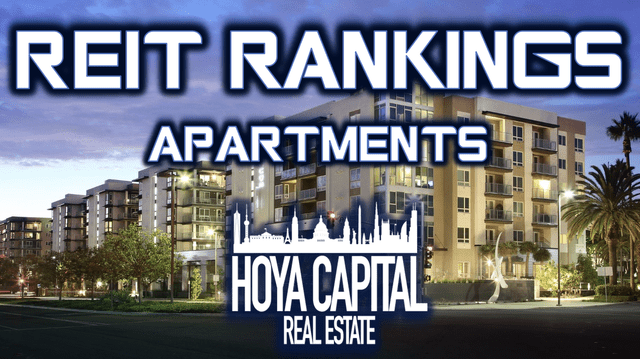
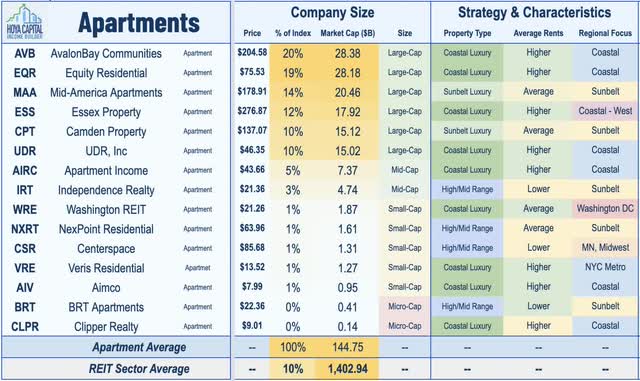
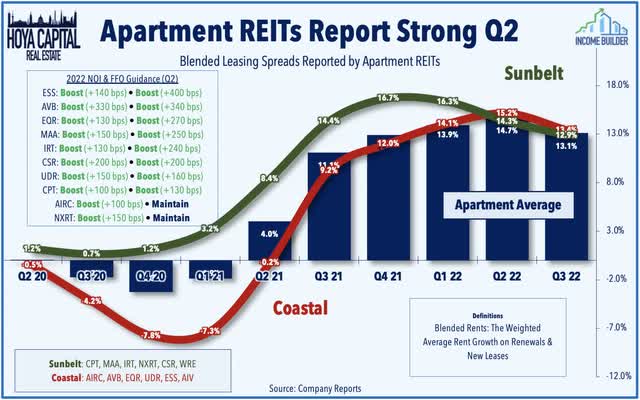
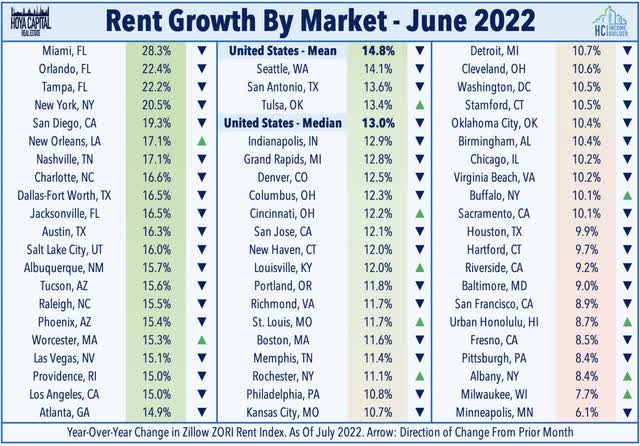
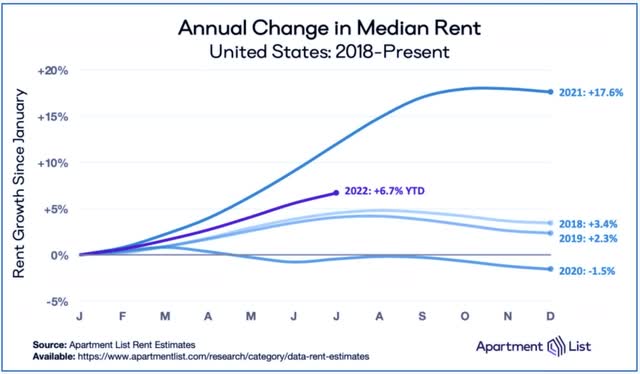
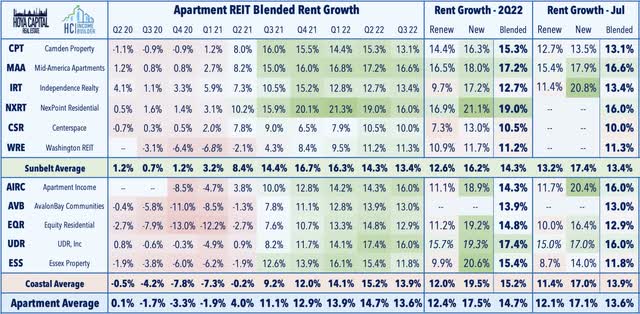
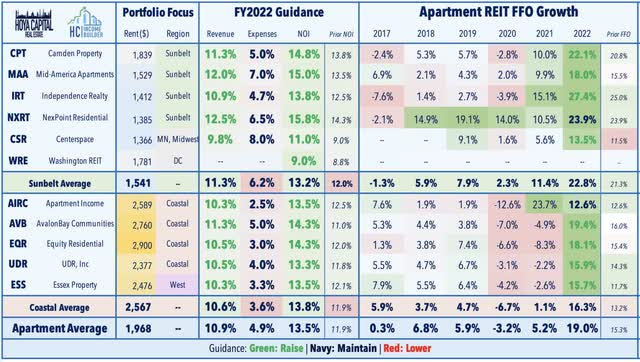
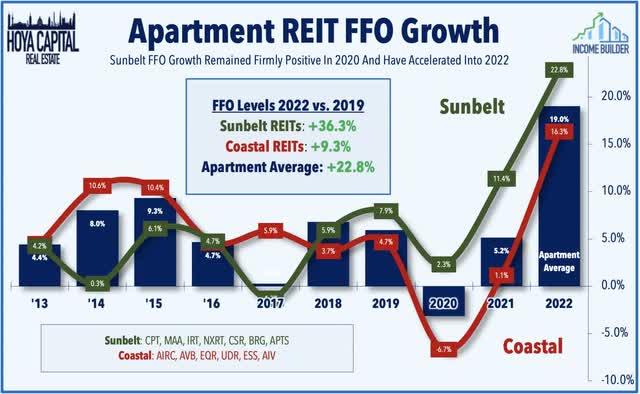
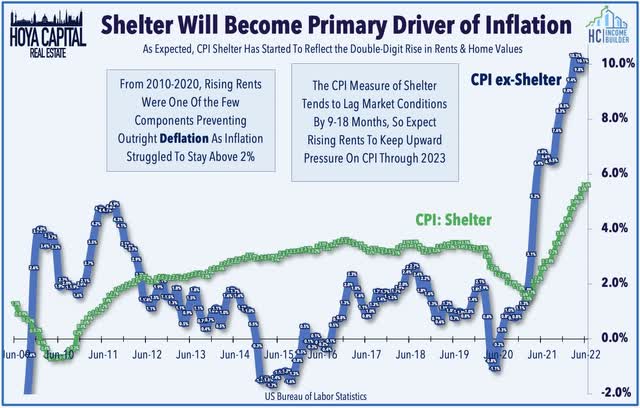
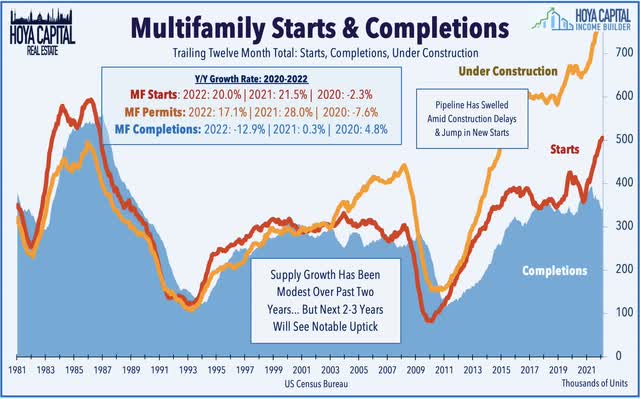
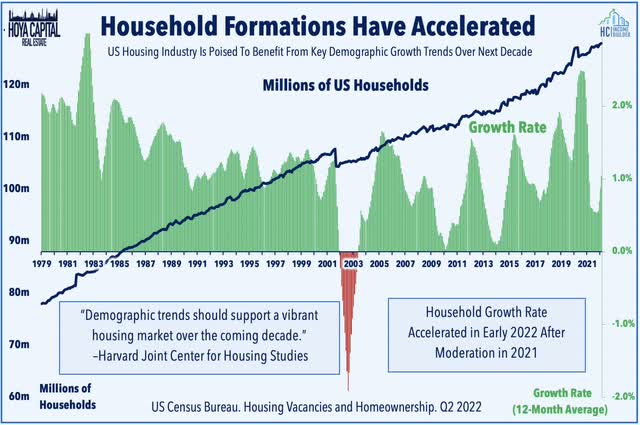
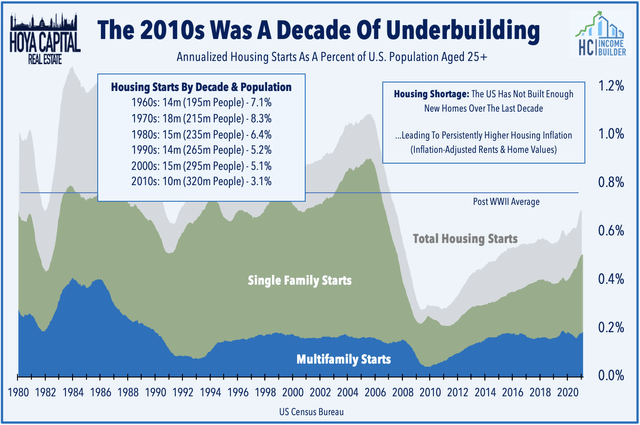
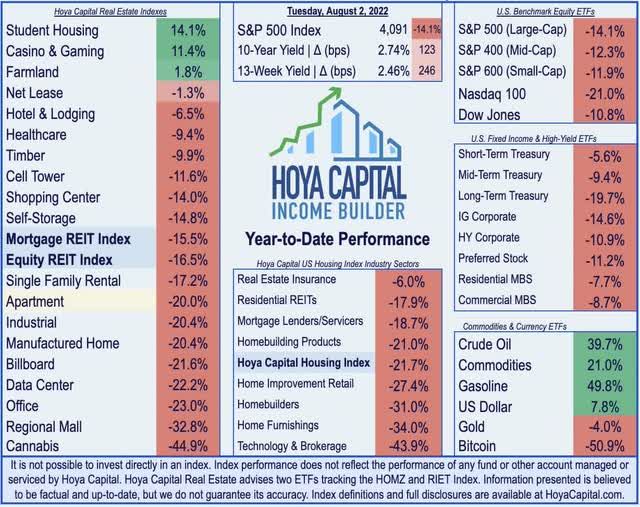
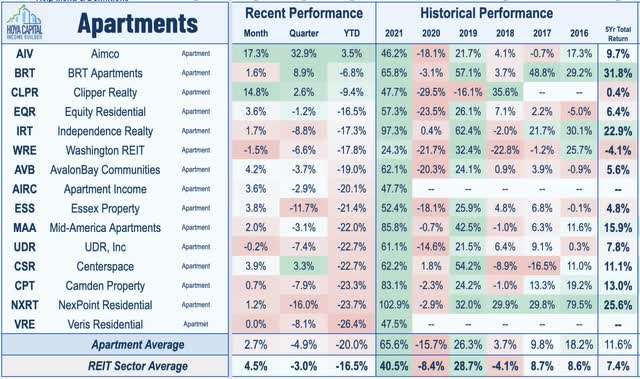
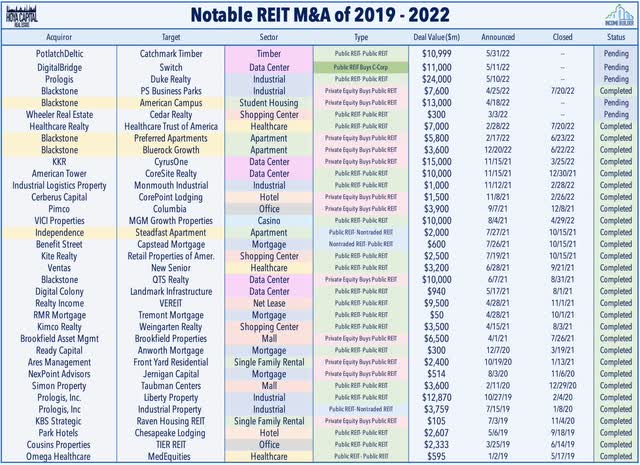
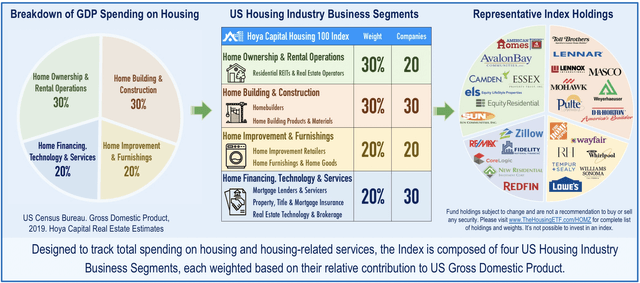
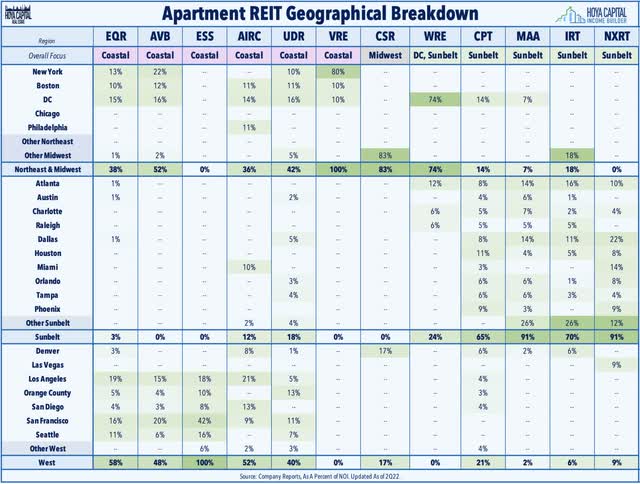
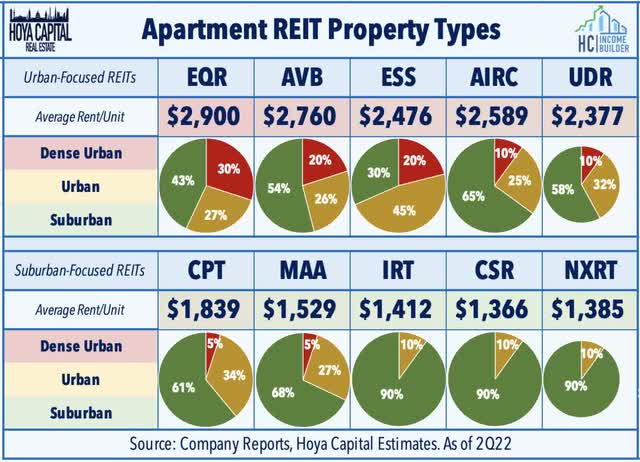
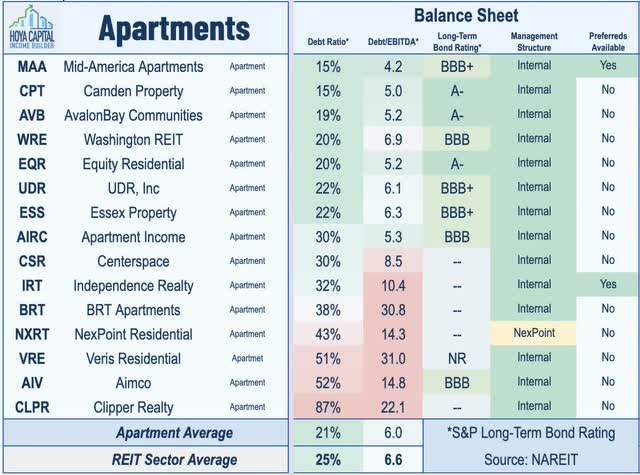
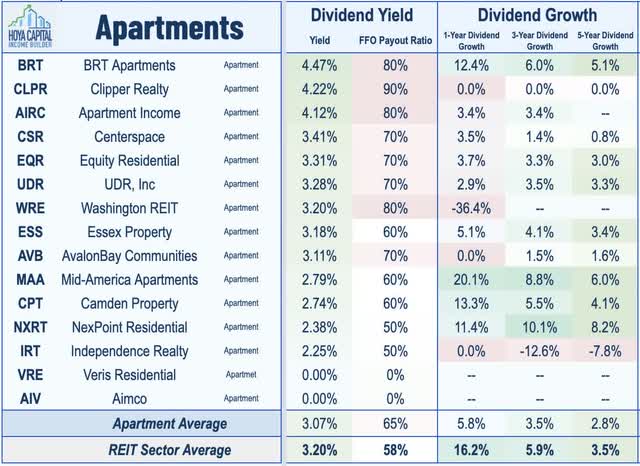
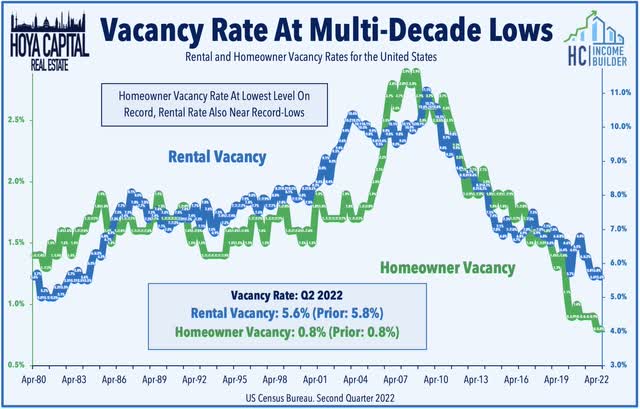
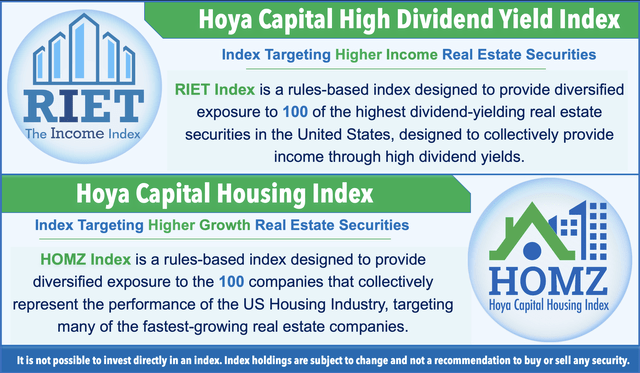
Be the first to comment